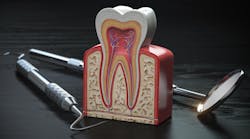What's inside:
- The keys to getting organized before the day starts
- The simple question to ask that keeps things moving
- "One of my favorite parts of the job"
Immediate collaboration
When I first started practicing dental hygiene, I worked in an office with four different dentists. Each dentist had a different focus for treatment. For example, one wanted to know everything about the patient’s medical history and how it related to his or her dental care, while another cared most about the risk for tooth decay and periodontal charting.
I learned very quickly that if I was not prepared for the examination, I would fumble in front of the patient. The periodic examination allows us to fully collaborate with the dentist—in front of the patient. Creating an efficient hygiene examination and handoff to the dentist not only increases case acceptance, it demonstrates our value as more than a “teeth cleaner.”
Get organized
Before each day begins, I review all my patients’ charts. I determine when the last radiographs were taken to verify what type of radiographs they may need during their visit. I evaluate the treatment plan and conclude if there is any treatment that has been recommended but not completed.
While the patient is in the chair, I follow up with a simple question: “Is there any additional information you need to complete this treatment?” The patient may have concerns about finances or how many appointments the restorative work will take. By understanding what the patient needs to complete the treatment, the team can find a solution.
Another aspect of the clinical assessment that I evaluate is patients’ periodontal charting and overall history throughout their last appointments. I determine if a patient needs a full periodontal charting that day, is overdue for hygiene therapy, or needs an updated complete medical history. Reviewing the patients prior to starting your day will allow you to have better workflow and time management, which increases your control of the appointment and reduces anxiety.
You might also be interested in: 5 ways to improve your clinical experience
Case presentation
This is one of my favorite parts about my job. I feel like when I present the patient’s case to the doctor in an organized format, the patient feels valued. Through effective case presentation, I show patients that they are valued, I listened, and I care about their overall oral and systemic health. I present in SOAP (subjective, objective, assessment, plan) format. I review their medical history, chief concerns, extraoral findings, periodontal health, restorative findings, what I recommended to improve their oral health, and what concerns I have for the doctor to evaluate. This is the second time for patients to hear information about their state of oral health, which will increase the importance of the education provided.
Small gestures matter
Before the dentist arrives to perform the examination, I make sure that the latest radiographs and periodontal charting are on the screen. This saves time for the dentist and enhances the patient experience because I can focus on providing the information without the doctor fumbling for the information. I place a fresh piece of gauze on the tray, wipe the mirror clean, and place the mirror, probe, and explorer separate from the kit. This makes the dentist’s job easier and again tells the patient we are a team that cares about the small details.
Exams first
One of the worst things a dentist can do to hygienists is make them wait longer than three minutes for a check. After three minutes of waiting, patients immediately start thinking about what's next on their to-do list. The sense of importance for their upcoming care is replaced with being irritated that their time is not valued. Any time after 20 minutes into the appointment, the doctor should provide an examination.
After this initial time, the dental hygienist will have collected the necessary data to provide an assessment and the doctor can make a diagnosis. This is one of the best ways to reduce chaos in the office, especially when trying to remain socially distant in the clinical environment. Once the doctor confirms the necessary treatment, the dental hygienist can alert the treatment coordinator to obtain the financial estimates for the patient and they can be scheduled effectively within their one-hour appointment.
Conclusion
Throughout my consulting, I have found that dentists do not come in early into the appointment because they feel the RDH will not be ready. Assessing the clinical charts prior to the appointments will allow us to be familiar with the case, better manage our time, and be ready to present earlier, as opposed to rushing around like a maniac to leave fifteen minutes at the end of the appointment to ask multiple times for a check. Everyone’s stress will be reduced when efficient exams are achieved.
Editor's note: Originally published in 2020 and updated as of May 2025.







